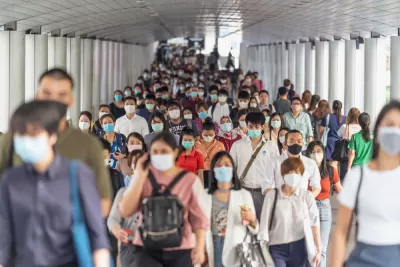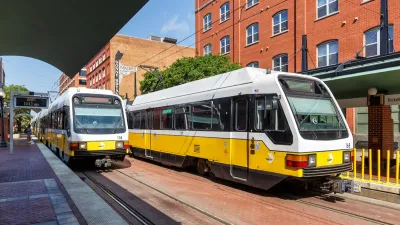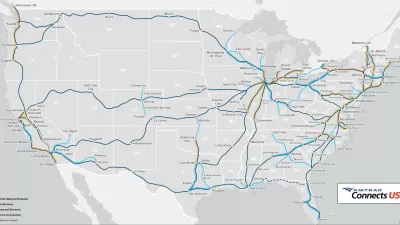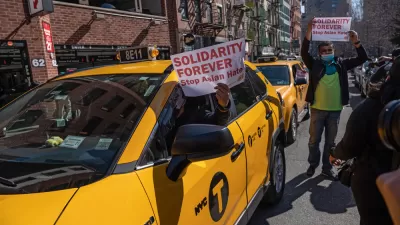Opinion: Six months into the pandemic, the state of the U.S. economy reveals that the planning profession can support struggling Americans by focusing on transportation and the land use patterns that enable mass transit.

A big, infographic-rich feature published by the New York Times this week, written by Ella Koeze, paints a detailed picture of the state of the U.S. economy at this point in history, more than six months after the coronavirus upended daily life. Included among the many data and graphics included in the article is a depressing fact of life: the inadequacies of the country's transportation infrastructure are holding back the economic recovery.
Unemployment has been slow to recover since it swelled to record numbers this spring, perpetuating one of the primary causes of pain and anxiety for Americans in world full of pain and anxiety. The recovery, such as it is, provides little reassurance, because it could vanish again at any moment, and because it looks different depending on how the data gets sliced up. One revelation from Koeze's deep dive into unemployment deals with the drag effect of transportation on the nation's recovery.
While the total number of unemployed is slowly shrinking, a growing number of people are becoming permanently unemployed. And the tally of people who aren’t looking for work because of family or transportation issues is staying much more consistent.
It's clear that many more unemployed people looking for work could be further challenged if another federal stimulus fails to provide funding for transit agencies on the brink of catastrophe without the revenue from pre-pandemic ridership levels. Those who need public transit the most are the most likely to suffer the consequences of federal inaction.
Let's be clear, the traditional, car-centric approach to planning isn't the prescription for what's ailing the economy. First, fewer people are on the roads, and it's likely to stay that way for a long time, as a portion of the workforce continues to work from home and another portion of the workforce continuing to deal with unemployment. The collective auto loan debt of Americans set a record in February 2020, threatening a debt crisis before the pandemic came to the United States. Nearly $66 billion of $1.33 trillion in auto loan debt was delinquent before the current economic crisis. While there is no shortage of completely reasonable concern about Americans defaulting on mortgages and facing eviction for lack of rent, another consequence of the pandemic depression is likely to be many Americans losing their cars.
In a more rational world, losing access to an automobile wouldn't have to be the tragedy that it is for many Americans. Public transit has consistently proven as the most effective economic development tool available to policy makers, and the failure of the United States to deliver adequate public transit infrastructure has been repeatedly shown to drag the economy. During the Great Recession, as many Americans struggled to deal with the costs of driving, areas located proximate to light rail transit showed resilience, according to research published in the journal Research in Transportation Economics in May 2019.
There has never been more evidence of the necessity for a dramatic shift in urban and regional planning norms than right now. The first step in the necessary process of change will be to find the funding necessary for public transit agencies to weather the storm of the current fiscal crisis—a challenge seemingly made impossible by the announcement yesterday that President Trump had pulled support for negotiations for a $2.2 trillion stimulus package that had been approaching the finish line in Congress. With or without the funding in place, transit agencies will have to make tough, but scientific, decisions about where and when to operate buses and trains to maximize the potential of operations (fortunately, there is already a lot of evidence about how to do so).
In the long-term, planners and policy makers must finally act to relax zoning restrictions in areas with access to high-quality jobs and mass transit. And public transit isn't the only kind of asset that delivers huge benefits in economic development and social mobility; the same is true of walkable urban neighborhoods. When, or if, the development industry and the public sector are ready for another rebound, planning and zoning must have prepared for the more efficient and equitable use of land that enables more efficient and equitable modes of transportation.
Those who need public transit the most are the most likely to suffer from federal inaction, but the communities most equipped to weather this storm and to move most confidently into the economic recovery must finally move beyond past failures to prioritize rational land use and public transit planning. In the absence of federal leadership, local governments will be forced, finally, to find ways to keep transit rolling, even if it means drastically shifting funding priorities (start by ending all road and highway expansion programs). The necessity for big, bold change is here, and now.

Study: Maui’s Plan to Convert Vacation Rentals to Long-Term Housing Could Cause Nearly $1 Billion Economic Loss
The plan would reduce visitor accommodation by 25,% resulting in 1,900 jobs lost.

Alabama: Trump Terminates Settlements for Black Communities Harmed By Raw Sewage
Trump deemed the landmark civil rights agreement “illegal DEI and environmental justice policy.”

North Texas Transit Leaders Tout Benefits of TOD for Growing Region
At a summit focused on transit-oriented development, policymakers discussed how North Texas’ expanded light rail system can serve as a tool for economic growth.

Paris Bike Boom Leads to Steep Drop in Air Pollution
The French city’s air quality has improved dramatically in the past 20 years, coinciding with a growth in cycling.

Why Housing Costs More to Build in California Than in Texas
Hard costs like labor and materials combined with ‘soft’ costs such as permitting make building in the San Francisco Bay Area almost three times as costly as in Texas cities.

San Diego County Sees a Rise in Urban Coyotes
San Diego County experiences a rise in urban coyotes, as sightings become prevalent throughout its urban neighbourhoods and surrounding areas.
Urban Design for Planners 1: Software Tools
This six-course series explores essential urban design concepts using open source software and equips planners with the tools they need to participate fully in the urban design process.
Planning for Universal Design
Learn the tools for implementing Universal Design in planning regulations.
Smith Gee Studio
Alamo Area Metropolitan Planning Organization
City of Santa Clarita
Institute for Housing and Urban Development Studies (IHS)
City of Grandview
Harvard GSD Executive Education
Toledo-Lucas County Plan Commissions
Salt Lake City
NYU Wagner Graduate School of Public Service






























